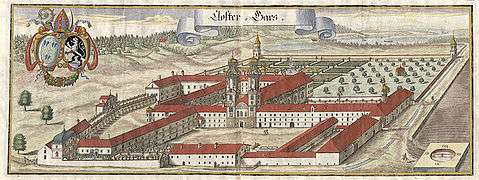Gars Abbey
|
Copper engraving of the Monastery by Johann Ulrich Kraus from the "Churbaierischen Atlas" of Anton Wilhelm Ertl, 1687 | |
 Location within Bavaria | |
| Monastery information | |
|---|---|
| Order | Congregation of the Most Holy Redeemer |
| Established | 768 |
| People | |
| Founder(s) | Tassilo III, Duke of Bavaria |
| Architecture | |
| Functional Status | In use |
| Site | |
| Coordinates | 48°09′23″N 12°16′35″E / 48.1565°N 12.2763°ECoordinates: 48°09′23″N 12°16′35″E / 48.1565°N 12.2763°E |
Gars Abbey (German: Kloster Gars) is a monastery on the Inn River in Bavaria, Germany, in the town of Gars. It was founded in 768, and has been occupied by Benedictine monks, Augustinian Canons Regular and most recently Redemptorists.
History
The monastery was founded in 768 by the cleric Boso from Salzburg for Tassilo III, Duke of Bavaria.[1] The monastery was originally called "Cella Garoz". For centuries it belonged to the archbishopric of Salzburg.[2] The Augustinian Canons erected the present monastery building after 1122.[2] In 1128 Bishop Conrad I of Salzburg transferred the monastery to the Augustinian Canons.[3]
In 1648 the Swedes pillaged and devastated the town and the monastery.[1] Under Provost Athanasius Peitlhauser the monastery was rebuilt between 1657 and 1659.[1] The monastery wings and the Church of the Assumption were renovated by Italian artists to their present form.[3] The pilaster church was rebuilt after 1661, one of the first Baroque churches in the region. The painted cast stone Pieta on a side altar dates from 1430, and was formerly the main altar of the church.[2] The monastery is interesting for the relics of the martyr Felix. Ceiling paintings and an altar show the importance of this saint to the monastery.[3]
In 1803 the Augustinian Canons were expelled as part of the Bavarian secularization program. The buildings and inventory were sold to private individuals.[1] In 1855 the Redemptorists showed an interest in Gars Monastery, and in 1858 they formally re-opened the monastery. Between 1873 and 1894 under the Kulturkampf only three fathers and brothers were allowed to remain. After the monastery was restored in 1894 the first missionaries were sent to Brazil.[1]
Today
As of 2013 the monastery housed about 16 brothers and 13 priests. The brothers follow various professions including work as bakers, butchers, gardeners, carpenters and tailors. The Fathers work as ward missionaries, helping in the surrounding communities and in education.[4] The monastery has a plant nursery that is well known in the region.[3]
Gallery
 View by Michael Wening (1645-1718)
View by Michael Wening (1645-1718)
 Front of the monastery church
Front of the monastery church Interior of the monastery church
Interior of the monastery church St. Anne (late gothic sculptural group)
St. Anne (late gothic sculptural group)
References
Citations
| Wikimedia Commons has media related to Kloster Gars. |
Sources
- "Die Klostergemeinde". Kloster Gars. Retrieved 2013-12-08.
- "Geschichte". Kloster Gars. Retrieved 2013-12-08.
- "Kloster Gars". Landratsamt Mühldorf. Retrieved 2013-12-08.
- Markus (4 November 2010). "Gars am Inn". Retrieved 2013-12-09.
